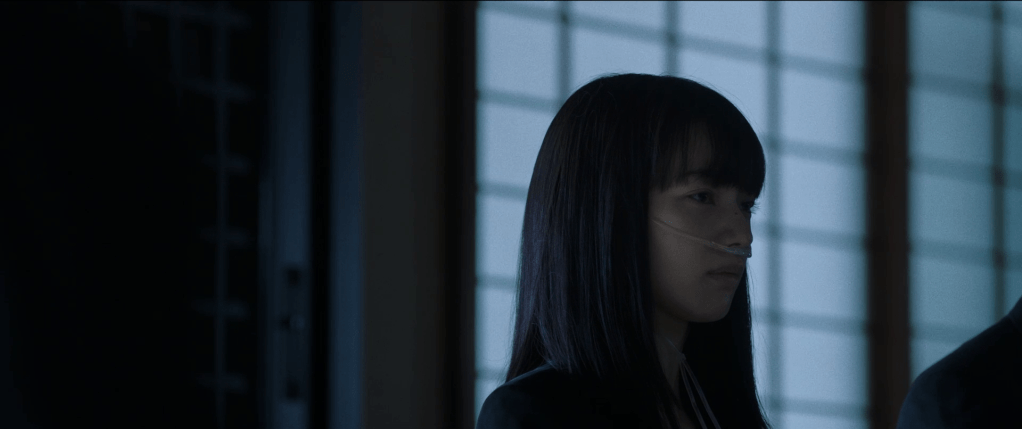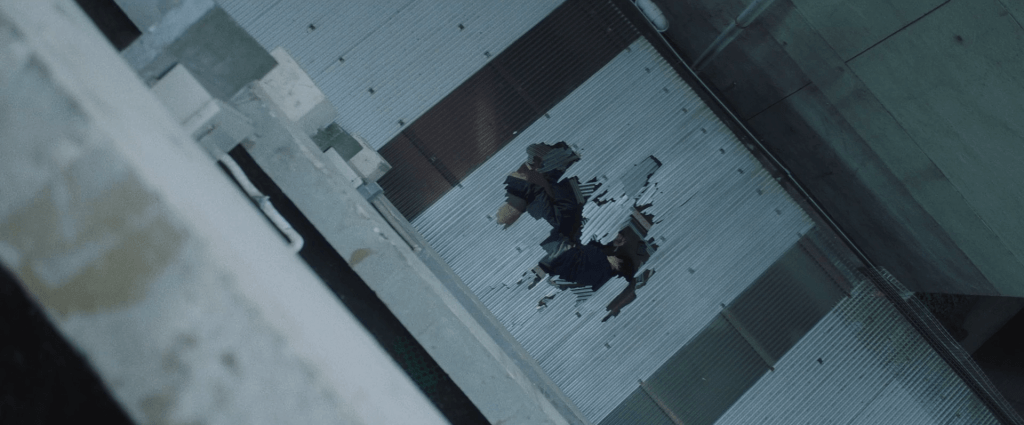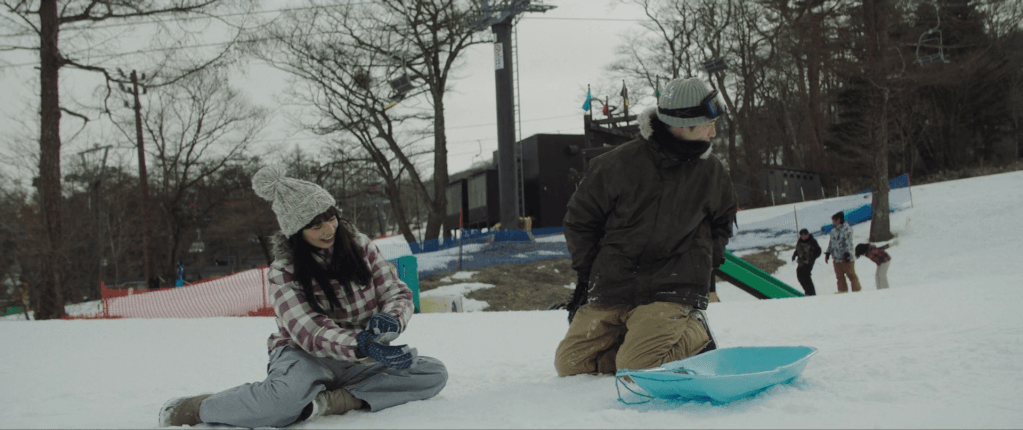Introduction
Michihito Fujii has a distinctive visual style that he has used to tackle a variety of genres. In Day And Night (2019) and in Yakuza and The Family (2021), for instance, he utilized his stylistic flair to stage a familial drama. In The Journalist (2019) he used it, to great effect, in a thriller-like narrative. Yet, can his visual style elevate a melodramatic narrative like The Last Ten Years, based on late Ruka Kosaka’s novel of the same name?
Review
After being in the hospital for two years, Matsuri Takabayashi (Nana Komatsu) is finally discharged (Narra-note 1). Yet, her discharge is not something truly worth of celebrating. While her body is strong enough to venture into society, it will only last for 10 years. Not long thereafter, she meets up with some of her university friends. Sanae Fujisaki (Nao) offers her a chance to work for her company, yet she refuses.
The same night, after coming home, she opens an invitation to a class reunion. Her older sister Kikyo (Haru Kuroki) teases her and says that she might fall in love. Matsuri tells her sister that she will not get into a relationship. At the reunion, she happens to meet Kazuto Manabe (Kentaro Sakaguchi), who is somewhat socially inhibited. Not that much later, he jumps out of the window of his apartment. On the day of his discharge, he happens to see Matsuri entering the outpatient ward.
The Last Ten Years does not merely offer tragic love story but presents the spectator an exploration of the struggle a subject faces when the radical presence of death complicates the will to live, the ability of the subject to find some meaning to his existence. While Fujii’s narrative follow many beats of Japanese romance narrative, the introduction of Matsuri’s future death at the beginning of the narrative ensures that The Last Ten Years avoids the trap of exploiting a sudden illness to force the tears of the spectator.
It is evident, from the beginning of the narrative, that the weight of her death foretold makes Matsuri afraid to live a life. In fact, her fear causes her to position herself within the societal field as an animated corpse, as someone who knows she is already dead. The signs of life that overflow in the speech of others make her feel uneasy and throw her into a state of hesitation – fear inhibits her, fear causes her to respond to other’s burst of life with defensive smiles. Furthermore, she chooses to refuse everything that might confront her too directly with the joys and pains of living, including the establishment of a romantic relationship.
Eventually, Matsuri does an effort to find a job, but she hits a brick wall due the blanks on her Curriculum Vitae and the inerasable truth of her illness. Yet, this attempt is not, as some might assume, driven by a sudden wish to join the society of the living, but is caused by the pressure she feels to inscribe herself in society’s demand – i.e. become a working member of society (Narra-note 2). Yet, eventually Matsuri accepts Sanae’s proposal, thereby taking a minimal step at inscribing herself, by writing articles for a website, in the societal field as a living subject.
Matsuri’s initial encounter with Kazuto is quite uneventful. Yet, she will soon meet him again, after his failed suicide attempt. Why did he try to commit suicide? In short, it is the sudden confrontation with the lack of his life’s purpose, with the mundane emptiness that fills his days, that compels him to jump out of his apartment’s window. The suicidal act was, in a certain way, born from his passive acceptance of the injury caused by the familial tangle (i.e. his parent’s desire to control).
Kazuto’s act confronts Matsuri with the fact that dissatisfaction, as born from a struggle in the symbolic-imaginary field, can move subjects to freely offer the remainder of their life to death. While Kazuto’s subjective struggle offends her – the destructive real that infest her body leaves her no other choice than to die, her tears elegantly evoke that she might be hearing her own unconscious suicidal impulse (Narra-note 3).
Yet, what allows Kazuto to change his subjective position within the societal field is the confrontation with the imagined pain that marks the Other, with the Real obstacle that ravages a subject’s physical life and complicates his desire to live. It is, in other words, by realizing that his obstacles are, in essence, subjective that he becomes an active writer of his own life, by for example starting a part-time job at a local restaurant owned by Gen Kajiwara (Lily Franky).
Matsuri refuses Kazuto’s romantic approaches solely because she struggles to give herself the right to live a life. She is, as a matter of fact, afraid to live because the radical loss of what she might get attached to is already decided, because she already considers herself dead. Yet, what allows her to grant herself the right to live until she dies (i.e. to let herself be in love with Kazuto) is the very repeated confrontation with his romantic desire, a desire that affirms his will to live (Narra-note 4). Other decisions Matsuri eventually makes (e.g. writing a novel, … etc.) are signs that she, faced with a death she cannot avoid, is trying to give the remainder of her existence some sort of meaning.
The questions eventually confronts the spectator with the following questions: How will Kazuto cope with the incurability of Matsuri’s disease? Will Matsuri, who grants herself the right to have a romance, not cause herself to become too attached to the relational joys of life? How can she, desiring to remain desiring and indulge in relational pleasure, prepare for the gaping nothing that is creeping closer? The way these questions are resolved within the narrative will surely make many spectators shed a tear – or even bawl their eyes out.
The composition of The Last Ten Years is commendable for its dynamism and his elegant (generally fixed) shot-compositions. The former gives a pleasant flow to the narrative and evokes, at times, the fleeting nature of time, while the latter, by not being overused, offers the spectator momentary moments of visual beauty. The visual pleasure of the composition is furthermore heightened by the natural lightning-design, the use of film-grain, and a subtle play with depth of field.
The inclusion of handy-cam footage within the composition is a smart move. As these moments give Matsuri as subject a sense of being grounded in reality – a sense of reality, of course, also supported by Nana Komatsu’s natural and elegantly layered performance, her struggle is able to attain the necessary emotionality to engage and move the spectator. Kentaro Sakaguchi, for that matter, succeeds, with an equally layered performance, in giving his character’s subjective transformation its necessary believability.
It should be evident that the musical accompaniment plays an important role in enabling emotionality into the narrative. Yet, it is not the simply beauty of the piano pieces that touches the spectator but the fact that because the slow rhythm of the music emphasizes those signifiers that evoke the sad longing of someone infested by death and those acts subtly echoing the acceptance of one’s end (Music-note 1). Moreover, due to the opening sequence, every touching of the key starts to function as a reminder of the ephemerality that marks our life. This does not only ensure that a subtle sadness echoes within the heart-warming moments but that the beauty of these moments, be it romantic or familial in nature, can be fully emotionally appreciated by the spectator.
The Last Ten Years offers a touching and satisfying tear-jerking experience. The reason why Fujii is able to deliver such a great narrative is not simply due to his visual enticing composition or the natural and layered performances by Komatsu and Sakaguchi, but because the narrative structure avoids exploiting the illness to force the tears of the spectator. While the musical accompaniment guides the emotions of the spectator, the emotionality of The Last Ten Years is genuinely evoked by Fujii’s compositional evocation of the ephemeral nature of time and the emotion the actors pour into their characters.
Notes
Narra-note 1: Opening the narrative with cherry-blossom and falling cherry-blossom pedals is not only about offering the spectator a sight of beauty, but to evoke from the very beginning that the narrative concerns the ephemeral nature of our existence on this planet.
Narra-note 2: This pressure does not merely blossom within her due to meeting others (i.e. her university friends and her old classmates at the reunion), but by reading her own time-capsule. Her own time-capsule functions, in certain sense, as a reminder of her past support to the ideal of societal normality.
Narra-note 3: There are other behaviours that might seem like bursts of life (e.g. Matsuri stuffing herself with food) at first glance, but reveal the destructive impulse that structured Matsuri’s subjective position.
Narra-note 4: Yet, Kazuto’s will to live seems intimately entangled with the presence of Matsuri. Matsuri functions does not merely as his object-of-desire, but the anchor that allows him to make something of his life. Can he, once Matsuri’s dies, find another element that can hook his desire to keep of living?
Music-note 1: As the striking of the keys is the most emotionally potent ingredient of the music, we chose not to mention the other instruments (e.g. strings) that, at times, are utilized in the musical accompaniment.






One Comment Add yours